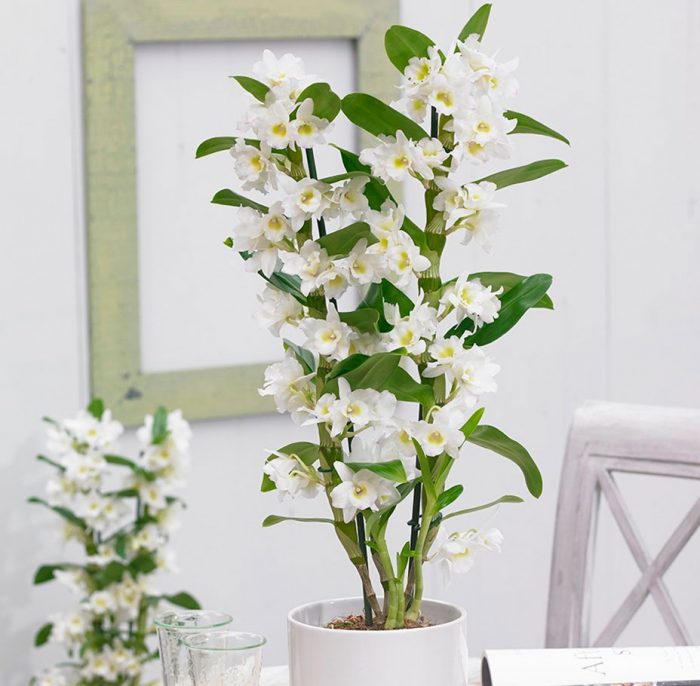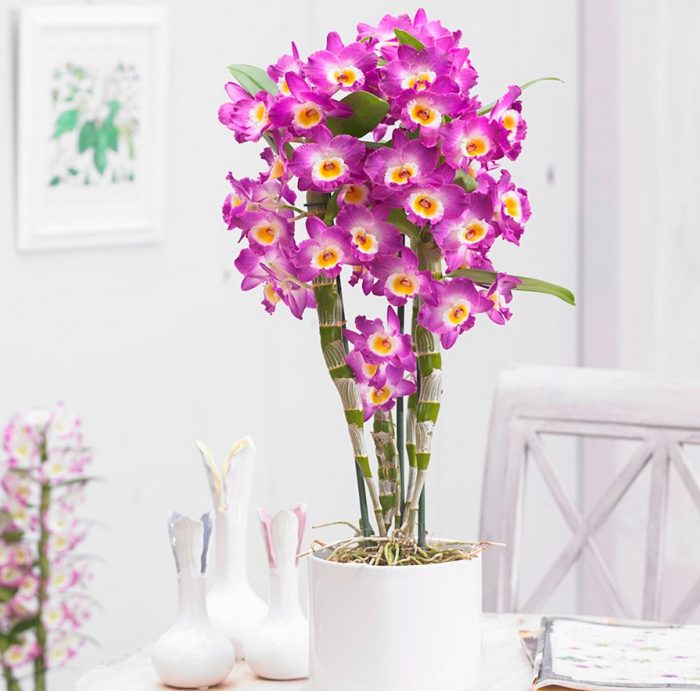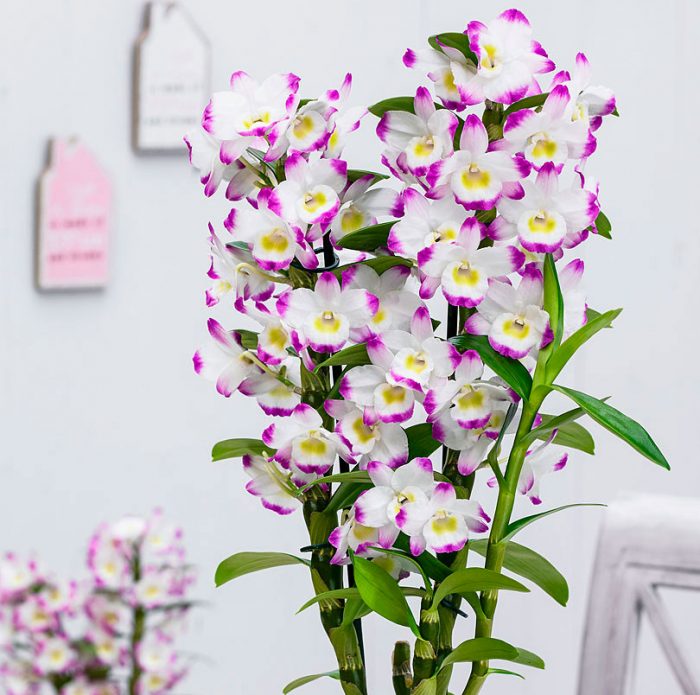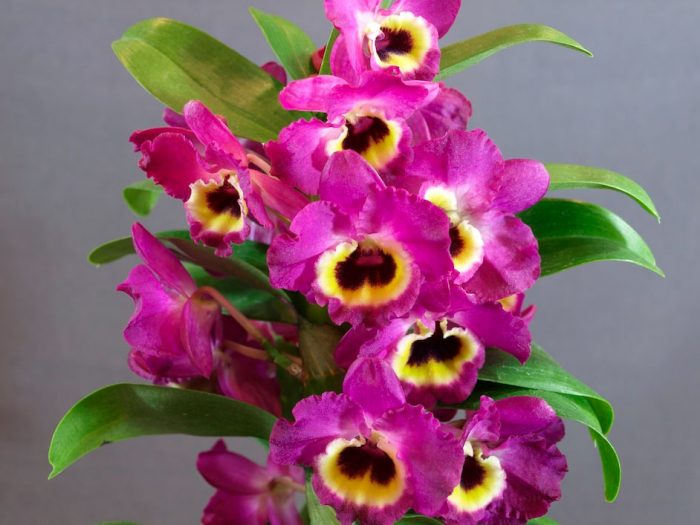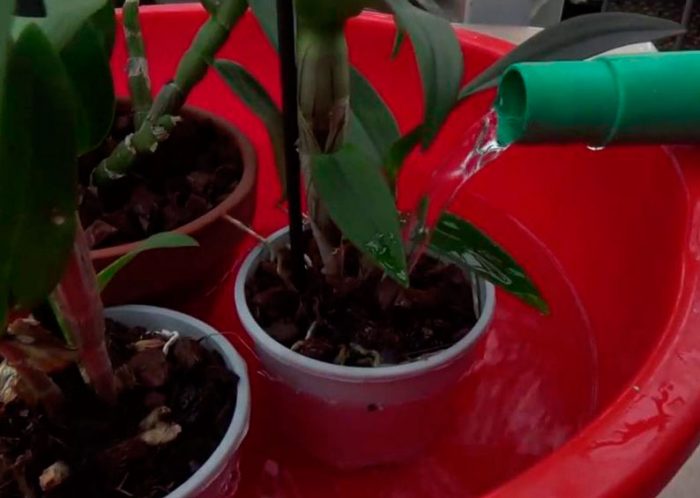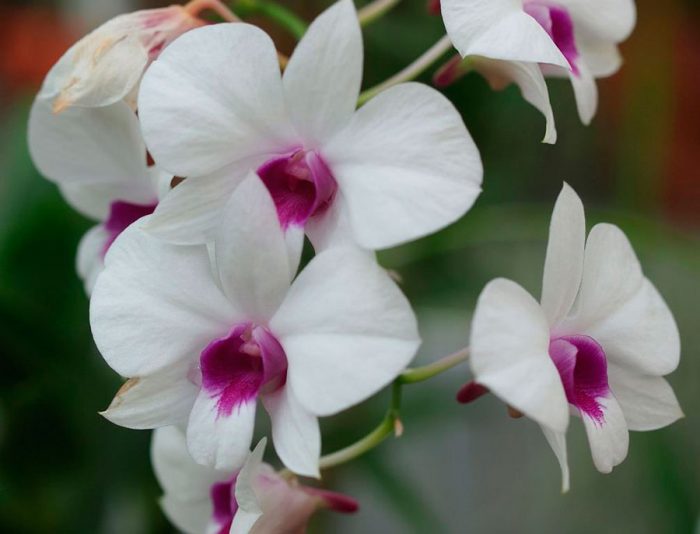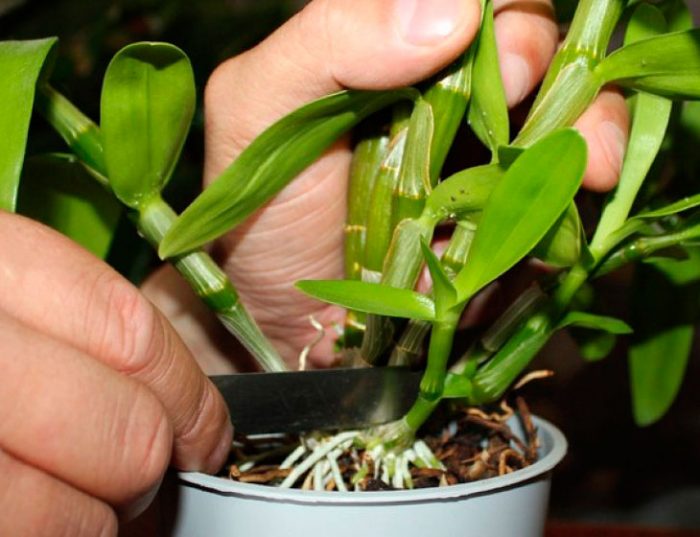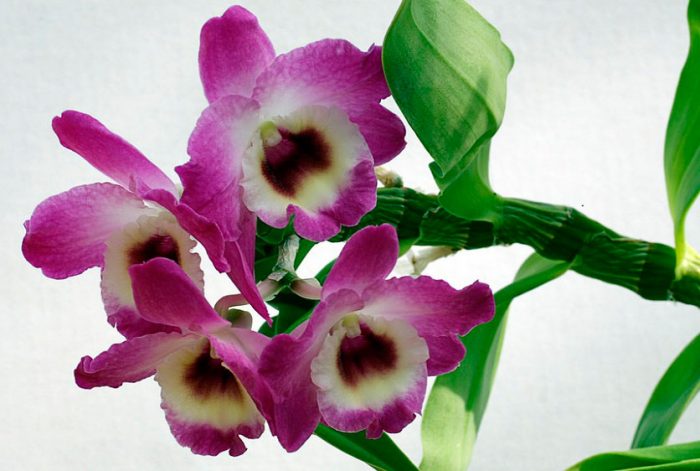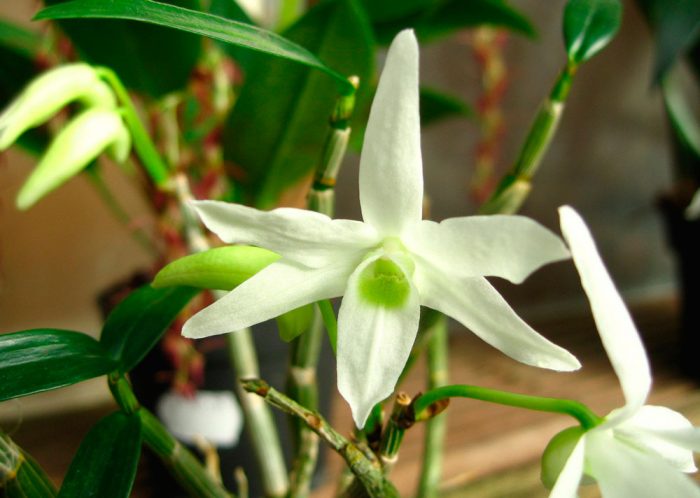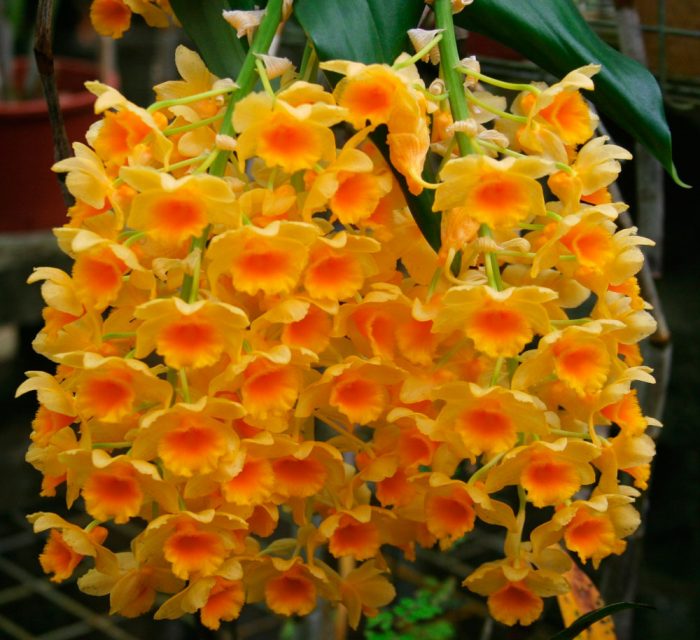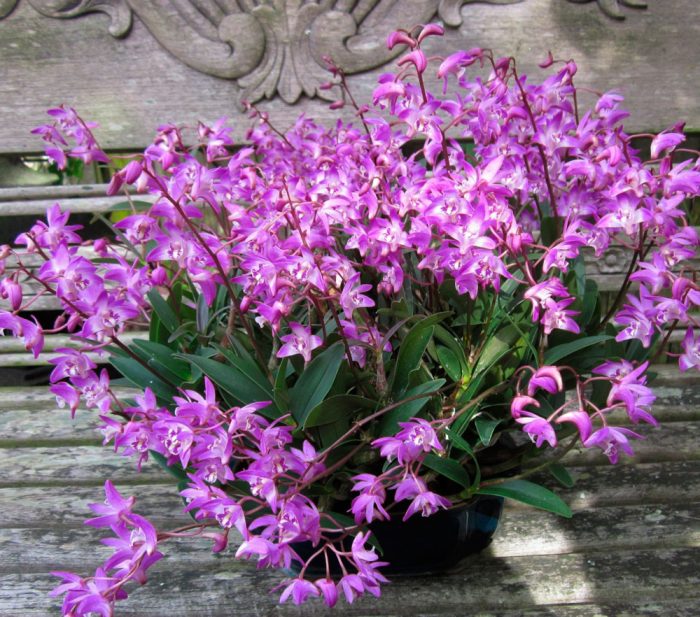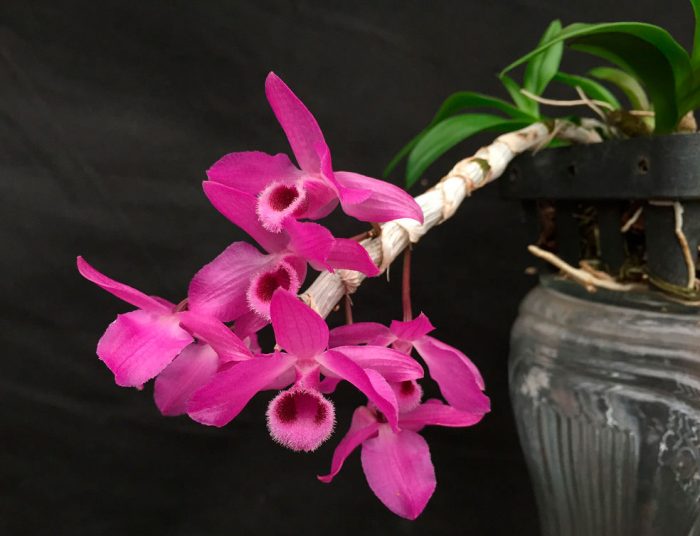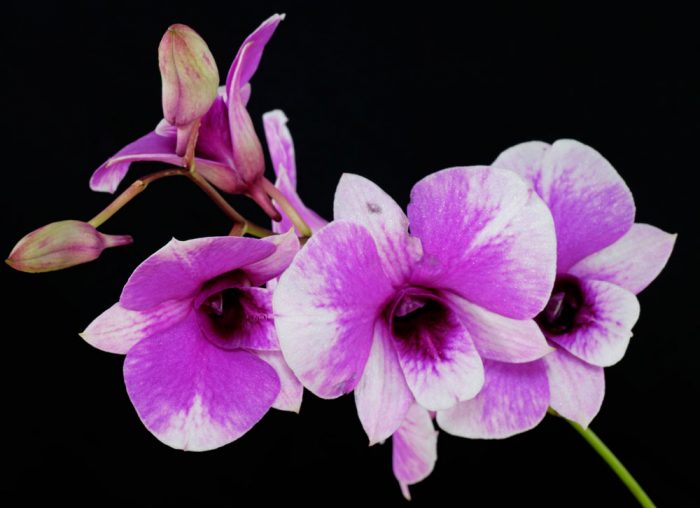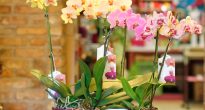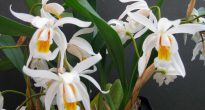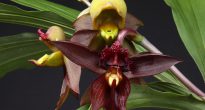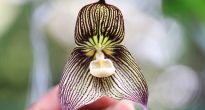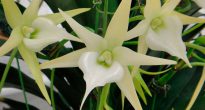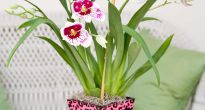A herbaceous perennial plant, the Dendrobium Orchid (Dendrobium) is a member of the Orchid family. From the Greek "dendrobium" translates as "living on a tree", this is due to the fact that this plant is an epiphyte, but among the species of this genus there are also lithophytes that live on stones. This genus unites more than 1200 species that can be found in natural conditions in the Philippines, Australia, New Zealand, Japan, China, Oceania and New Guinea. All these species can differ greatly from each other both in the shape and color of foliage and flowers, and in the manner of placing flowers on the stem, flowering time, and much more.
Content
Brief description of cultivation
- Bloom... Its duration is from 2 to 3 months.
- Illumination... Needs a lot of bright light, which must be diffused, do not allow direct sunlight to hit the bush. The duration of daylight hours should be at least 12 hours.
- Temperature regime... During active growth in the daytime - from 20 to 25 degrees, and at night - from 16 to 21 degrees. Types of cool content in the spring-summer period need temperatures from 15 to 18 degrees during the day, and about 12 degrees at night. In winter, the air temperature in the daytime should be about 12 degrees, and at night - about 8 degrees. The nighttime temperature should differ from the daytime by 5-7 degrees.
- Watering... In the spring-summer period, it is necessary to moisten the substrate in the pot abundantly, and during the dormant period, watering should be scarce.
- Air humidity... Required high humidity (from 50 to 80 percent). Therefore, the bush must be often moistened with lukewarm water from a sprayer. In winter, the container with the flower is best placed on a tray filled with damp rubble.
- Fertilizer... During the growing season (in April – September), the flower is fed once every 15 days with a solution of complex mineral fertilizer for orchids.
- Dormant period... It comes after the bush has faded, while the timing depends on the type of dendrobium.
- Transfer... Systematically every 3 or 4 years.Autumn-flowering species are transplanted immediately after the appearance of young shoots, and spring-flowering ones - when flowering ends.
- Reproduction... Cuttings or dividing the bush.
- Harmful insects... Spider mites, thrips, scale insects, mealybugs and whiteflies.
- Diseases... Root rot, leaf blight, powdery mildew and brown rot.
Dendrobium orchid care at home
Growing features
Since there are so many different types of dendrobium orchids, which differ from each other in agricultural technology, it is simply impossible to describe the rules for growing in indoor conditions for all types of such a plant at once. The fact is that almost every species has its own "whims" that must be taken into account when growing it. However, dendrobium has several general requirements:
- Growing any of the species at home is a very difficult process.
- Each of the species should be grown according to those agrotechnical rules that apply specifically to it, otherwise the plant may die.
- All species prefer bright light, which must be necessarily diffused. The flower must be protected from direct sunlight.
- Also, all species react extremely negatively to a draft.
- Flowers growing in natural conditions do not need a rest period.
Temperature regime
Remember that each of the species of this plant has its own requirements for air temperature. For example, they are all divided into 6 groups according to the conditions of the optimal growing temperature. Moreover, each of these groups has special requirements for the temperature regime. However, on average, for those species that are considered thermophilic, during the growing season in the warm season, the air temperature is optimal during the day - from 20 to 25 degrees, and at night - from 16 to 21 degrees. In winter, during the daytime, the room should not be warmer than 20 degrees, and at night - colder than 18 degrees. Types of cool content in the warm season during the day need not too high air temperature (from 15 to 18 degrees), at night it should be about 12 degrees. And in the winter months, about 12 degrees during the daytime, and about 8 degrees at night.
Illumination
Most species, as well as varieties of this plant, need bright lighting, but the flower must be protected from the direct scorching rays of the sun. For it to grow and develop within normal limits, the duration of daylight hours should be only about 12 hours.
Watering and air humidity
Dendrobium is watered in almost the same way as other types of orchids. In the spring-summer period, watering should be abundant, but it is impossible to allow liquid stagnation in the substrate, as this may cause rot on the root system. Watering should be done with filtered or well-settled water at room temperature.
Such a plant needs high humidity, the level of which should be from 50 to 80 percent. In order to provide the plant with the necessary moisture level in the summer, it is recommended to move it outside and moisturize the foliage as often as possible. In winter, a container with a flower is placed on a tray filled with moistened gravel.


Watch this video on YouTube
Dendrobium transplant
Dendrobium transplants are extremely painful, so they are carried out as rarely as possible, about 1 time in 3 or 4 years. Species blooming in spring are transplanted as soon as they fade, and autumn flowering - only when young shoots begin to grow. The pot is chosen not very large, while it can be made of any material. Seasoned growers usually choose unglazed clay flowerpots, and those who grow an orchid for the first time usually plant it in translucent plastic pots.
It is imperative to put several heavy small stones on the bottom of the container to make it more stable. On top of the stones, a drainage layer is made of foam or expanded clay. Then a layer of bark of a coarse fraction is poured and the flower is carefully transferred into a new pot, all the voids are filled with a new substrate. For planting orchids, experienced florists advise using a commercially available orchid substrate. As a rule, for planting such a flower, they take a mixture consisting of charcoal, sphagnum, pine bark and coconut chips. However, it can also be grown in a substrate consisting of only bark.
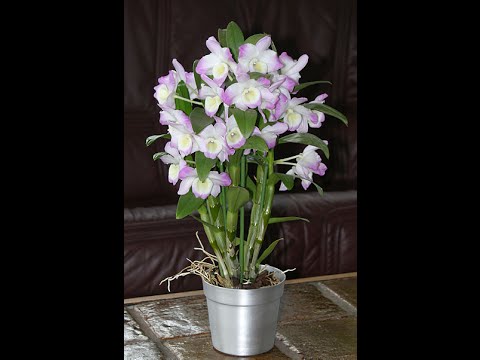

Watch this video on YouTube
Fertilizer
The orchid is fed only during intensive growth in April – September, once every 15 days. To do this, use a liquid complex fertilizer for orchids. Please note that the concentration of the formula used should be half as low as recommended by the manufacturer. If you use a nutrient mixture of a higher concentration, this can damage the root system, which will lead to the death of the plant. In addition to this general rule for all dendrobiums, varieties and types of warm content require regular feeding with potassium-phosphorus fertilizer even in winter, such a nutrient mixture is added to the substrate once every 4 weeks. At the same time, types of cool content are fed with nitrogen fertilizer twice or three times a month.
Flowering features
Care rules during flowering
Each type of dendrobium orchid blooms in its own time, while the duration of flowering can vary from 2 to 3 months. In order for the plant to bloom in a timely manner, a temperature difference of 5-7 degrees at night and during the day is recommended. The easiest way to achieve this is in the summer, and in winter the matter is complicated by round-the-clock heating of the premises.
When growing dendrobium nobile in winter, in order to make it bloom, some growers resort to an unusual method. They do not water the bush until new growth appears. When this growth in height reaches 20-30 mm, and it grows its own roots, watering of the flower is resumed. After the growth is equal to the old bulbs, a gradual reduction of watering is carried out until it stops completely, while the temperature is reduced to 12 degrees. Watering is resumed only when the formed buds begin to bloom, otherwise children will develop instead of flowers.


Watch this video on YouTube
Post-flowering care
After the flowering is over, they begin to gradually reduce watering until it stops completely, the peduncle is cut off, and the bush itself is transferred to a place where it is always cool. In this case, he will be able to have a good rest and gain strength before a new flowering. Dendrobium growing in nature does not stop growing even in winter, however, in mid-latitudes during the cold season, due to poor lighting, it hibernates, at which time its growth stops. Of course, he will not die from this, but experts do not recommend this. In winter, when the daylight hours are very short, the bush must be supplemented, and it is best to use a phytolamp for this. The fact is that an orchid growing in nature does not have a dormant period, it is constantly busy with something, as a rule, the flower grows either foliage, or roots, or peduncles. If your flower fell into hibernation in autumn, then you should not disturb it. In this case, watering is temporarily stopped and the bush is transferred to a cool place.
Reproduction methods
Dividing the bush
Indoor dendrobium orchid can be propagated by dividing the bush. The plant is divided during transplantation after it has faded. An adult large bush is taken out of the container and divided into parts after the root system is freed from the substrate.In this case, first you need to carefully untangle the roots, and then those that are very tangled are cut with a sharp disinfected tool. During the division, it should be taken into account that on each division there should be 2 or 3 mature bulbs and the same number of young growths. Places of cuts are treated with garden varnish or sprinkled with coal powder.
Cuttings
Cut the pseudobulb from the parent bush and cut it into cuttings, which should be about 10 centimeters long. Places of cuts are coated with garden varnish. Take a tight-fitting plastic bag and fill it with moistened sphagnum. Place one or two cuttings in each bag, then fasten them tightly and put them in a warm (from 22 to 25 degrees) and well-lit place, keep in mind that the light must be diffused. Air the cuttings every day and make sure that the sphagnum is always damp (not wet). Cuttings will take root after 15–20 days, after which they can be planted in separate pots. The bushes that grow out of them will bloom for the first time after 2 or 3 years.
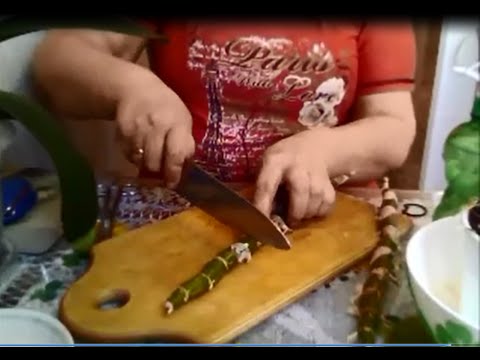

Watch this video on YouTube
Types of dendrobium with photos and names
There are many different types and varieties of dendrobium orchids, so it is very difficult to single out the best or the most beautiful ones. Below will be described those species and varieties that are most popular with flower growers.
Dendrobium noble (Dendrobium nobile)
This species is one of the most beautiful, it comes from Vietnam and the Himalayas. The length of the shiny thick pseudobulbs is about half a meter, in the second year of growth they form peduncles, on which 1-3 large (about 10 centimeters in diameter) flowers of a saturated color are formed. In a natural species, the petals are white and have lavender tips, the lips are creamy with pink edging, and the throat is dark purple. Hybrid varieties can bloom several times a year.
Dendrobium moniliforme
This species is Japanese endemic. It is a reduced copy of the noble dendrobium, the height of the bush is only about 15 centimeters. This species, in comparison with the others, is less demanding to care for, so it is recommended to pay attention to it for inexperienced growers.
Dendrobium densiflorum
This epiphyte is native to the Eastern Himalayas. Its drooping lush racemose inflorescences reach about 0.3 meters in length, up to 50 very fragrant flowers can form on them, the sepals and petals of which are rich yellow, and the lip is orange-yellow shaggy and fringed along the edge. This species has a variety - Dendrobium thyrsiflorum: its petals are colored cream or white.
Dendrobium kingianum
The homeland of such a plant is Australia. Almost cylindrical stems are thickened in the lower part, and in the upper part, they form wide leaf plates. The peduncle grows 5 or more fragrant pinkish flowers with a spotted lip. The growth of the bush continues throughout the year, and it blooms in February – March.
Dendrobium parishii
In this epiphyte, drooping shoots reach about 0.3 meters in length (sometimes more). The length of the leaf plates is from 7 to 12 centimeters, they are pointed and have an oblong-lanceolate shape. Amethyst-purple single flowers have a strongly pubescent rounded lip with brownish-purple specks. The column is painted white and the boot is purple. Blooming is observed in June – July.
Dendrobium phalaenopsis (Dendrobium phalaenopsis)
In nature, this species is found in Australia, its flowers are very similar to the phalaenopsis orchid, which influenced the choice of the name. The length of the pseudobulbs with powerful leathery leaf blades is about 0.7 m.On a high peduncle, about 10 (sometimes more) large burgundy flowers are formed in diameter, reaching up to 80 mm. Each of the flowers blooms for about 8 weeks, while the old pseudobulbs can bloom several times. The bush blooms in November-December.
Best suited for beginner florists is such a species as dendrobium phalaenopsis or dendrobium noble.

